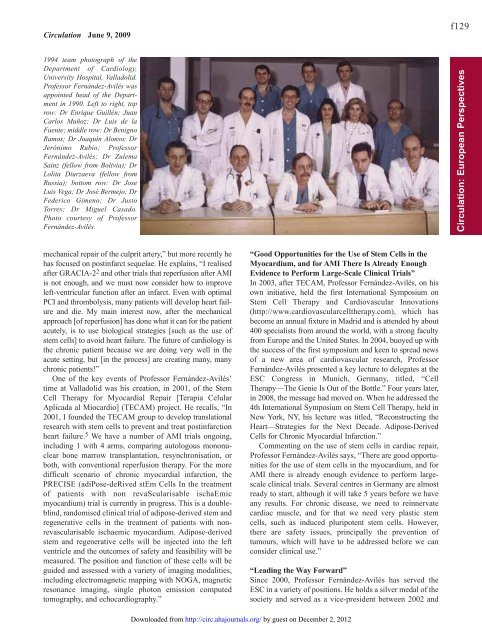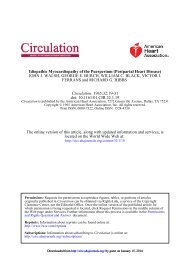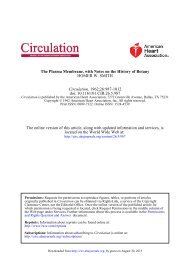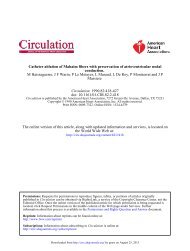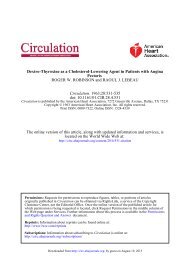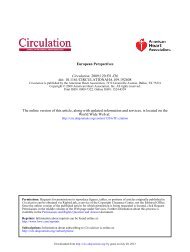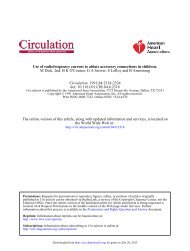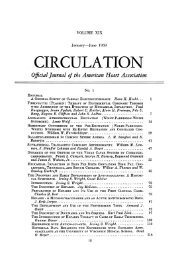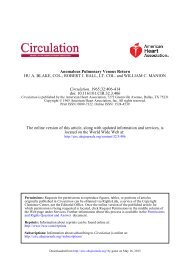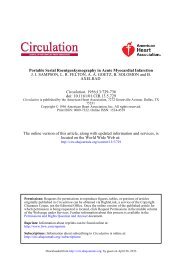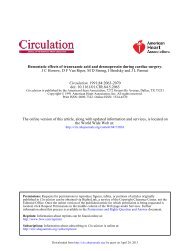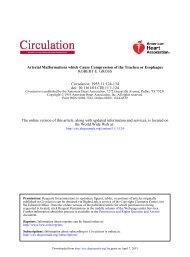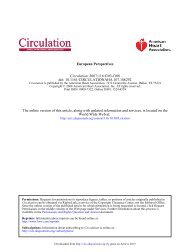Francisco Fernández-Avilés, MD, PhD, FESC, FACC - Circulation
Francisco Fernández-Avilés, MD, PhD, FESC, FACC - Circulation
Francisco Fernández-Avilés, MD, PhD, FESC, FACC - Circulation
Create successful ePaper yourself
Turn your PDF publications into a flip-book with our unique Google optimized e-Paper software.
<strong>Circulation</strong> June 9, 2009<br />
1994 team photograph of the<br />
Department of Cardiology,<br />
University Hospital, Valladolid.<br />
Professor <strong>Fernández</strong>-<strong>Avilés</strong> was<br />
appointed head of the Department<br />
in 1990. Left to right, top<br />
row: Dr Enrique Guillén; Juan<br />
Carlos Muñoz; Dr Luis de la<br />
Fuente; middle row: Dr Benigno<br />
Ramos; Dr Joaquín Alonso; Dr<br />
Jerónimo Rubio; Professor<br />
<strong>Fernández</strong>-<strong>Avilés</strong>; Dr Zulema<br />
Sainz (fellow from Bolivia); Dr<br />
Lolita Diurzaeva (fellow from<br />
Russia); bottom row: Dr Jose<br />
Luis Vega; Dr José Bermejo; Dr<br />
Federico Gimeno; Dr Justo<br />
Torres; Dr Miguel Casado.<br />
Photo courtesy of Professor<br />
<strong>Fernández</strong>-<strong>Avilés</strong>.<br />
mechanical repair of the culprit artery,” but more recently he<br />
has focused on postinfarct sequelae. He explains, “I realised<br />
after GRACIA-2 2 and other trials that reperfusion after AMI<br />
is not enough, and we must now consider how to improve<br />
left-ventricular function after an infarct. Even with optimal<br />
PCI and thrombolysis, many patients will develop heart failure<br />
and die. My main interest now, after the mechanical<br />
approach [of reperfusion] has done what it can for the patient<br />
acutely, is to use biological strategies [such as the use of<br />
stem cells] to avoid heart failure. The future of cardiology is<br />
the chronic patient because we are doing very well in the<br />
acute setting, but [in the process] are creating many, many<br />
chronic patients!”<br />
One of the key events of Professor <strong>Fernández</strong>-<strong>Avilés</strong>’<br />
time at Valladolid was his creation, in 2001, of the Stem<br />
Cell Therapy for Myocardial Repair [Terapia Celular<br />
Aplicada al Miocardio] (TECAM) project. He recalls, “In<br />
2001, I founded the TECAM group to develop translational<br />
research with stem cells to prevent and treat postinfarction<br />
heart failure. 5 We have a number of AMI trials ongoing,<br />
including 1 with 4 arms, comparing autologous mononuclear<br />
bone marrow transplantation, resynchronisation, or<br />
both, with conventional reperfusion therapy. For the more<br />
difficult scenario of chronic myocardial infarction, the<br />
PRECISE (adiPose-deRived stEm Cells In the treatment<br />
of patients with non revaScularisable ischaEmic<br />
myocardium) trial is currently in progress. This is a doubleblind,<br />
randomised clinical trial of adipose-derived stem and<br />
regenerative cells in the treatment of patients with nonrevascularisable<br />
ischaemic myocardium. Adipose-derived<br />
stem and regenerative cells will be injected into the left<br />
ventricle and the outcomes of safety and feasibility will be<br />
measured. The position and function of these cells will be<br />
guided and assessed with a variety of imaging modalities,<br />
including electromagnetic mapping with NOGA, magnetic<br />
resonance imaging, single photon emission computed<br />
tomography, and echocardiography.”<br />
“Good Opportunities for the Use of Stem Cells in the<br />
Myocardium, and for AMI There Is Already Enough<br />
Evidence to Perform Large-Scale Clinical Trials”<br />
In 2003, after TECAM, Professor <strong>Fernández</strong>-<strong>Avilés</strong>, on his<br />
own initiative, held the first International Symposium on<br />
Stem Cell Therapy and Cardiovascular Innovations<br />
(http://www.cardiovascularcelltherapy.com), which has<br />
become an annual fixture in Madrid and is attended by about<br />
400 specialists from around the world, with a strong faculty<br />
from Europe and the United States. In 2004, buoyed up with<br />
the success of the first symposium and keen to spread news<br />
of a new area of cardiovascular research, Professor<br />
<strong>Fernández</strong>-<strong>Avilés</strong> presented a key lecture to delegates at the<br />
ESC Congress in Munich, Germany, titled, “Cell<br />
Therapy—The Genie Is Out of the Bottle.” Four years later,<br />
in 2008, the message had moved on. When he addressed the<br />
4th International Symposium on Stem Cell Therapy, held in<br />
New York, NY, his lecture was titled, “Reconstructing the<br />
Heart—Strategies for the Next Decade. Adipose-Derived<br />
Cells for Chronic Myocardial Infarction.”<br />
Commenting on the use of stem cells in cardiac repair,<br />
Professor <strong>Fernández</strong>-<strong>Avilés</strong> says, “There are good opportunities<br />
for the use of stem cells in the myocardium, and for<br />
AMI there is already enough evidence to perform largescale<br />
clinical trials. Several centres in Germany are almost<br />
ready to start, although it will take 5 years before we have<br />
any results. For chronic disease, we need to reinnervate<br />
cardiac muscle, and for that we need very plastic stem<br />
cells, such as induced pluripotent stem cells. However,<br />
there are safety issues, principally the prevention of<br />
tumours, which will have to be addressed before we can<br />
consider clinical use.”<br />
“Leading the Way Forward”<br />
Since 2000, Professor <strong>Fernández</strong>-<strong>Avilés</strong> has served the<br />
ESC in a variety of positions. He holds a silver medal of the<br />
society and served as a vice-president between 2002 and<br />
Downloaded from<br />
http://circ.ahajournals.org/ by guest on December 2, 2012<br />
f129<br />
<strong>Circulation</strong>: European Perspectives


